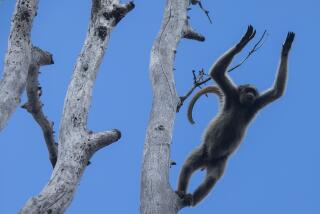Boa constrictor eats a howler monkey while scientists watch [Photos]
Scientists have caught the first images of a boa constrictor consuming a 9-pound howler monkey, and they are gruesome.
In the gallery above, you will see the boa constrictor ingesting the monkey head-first, bit by bit.
The images accompany a study describing a play by play of the snake attack published in the journal Primates by Julio Cesar Bicca-Marques of Pontifical Catholic University of Rio Grande do Sul and his student Erika Patricia Quintino.
Quintino captured the images while habituating a group of six Purus red howler monkeys (Alouatta puruensis) to her presence so she could conduct a behavioral study, Bicca-Marques told the L.A. Times in an email.
Biologists know that snakes do occasionally feast on primates, but the authors say no one had ever documented a boa constrictor attack on a monkey this large until now.
The drama depicted above began at 11:45 a.m., when two females ventured away from the group of six into a neighboring tree, where a 6 1/2-foot boa constrictor was lying in wait.
The snake hit one of the female monkeys on the head with its mouth open, and then coiled its body around her neck and torso.
The victim let out a shriek, which alerted Quintino that something interesting was about to occur. As she watched, the second female monkey ran to the scene, and hit the snake with her hands. The boa constrictor ignored her and kept squeezing. After four to 10 slaps, the survivor monkey moved to a nearby tree.
The scientists say it probably took the victim monkey just five minutes to die from cardiac arrest, but the the snake held on tight for a full 15 minutes.
Then, it began to ingest its prey.
Holding the howler by its head, the boa uncoiled and stretched its body vertically while clinging to a tree branch with its tail, the researchers wrote.
“Then, it coiled again, moved its head around the victim’s body, and started to swallow her head first. “
It took 38 minutes from the snake’s strike to the start of ingestion, and the process of swallowing the monkey took 76 minutes, they said.
In the published paper, the researcher suggest that boa constrictors that hunt in trees may pose more of a threat to howler monkeys than previously thought.
“This event indicates that even large-bodied atelids (a family of new world monkeys) are vulnerable to predation by large snakes and suggests that boa constrictor may be a more common predator of primates,” they conclude.






